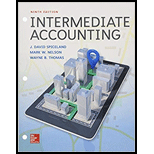
Concept explainers
Error correction; change in
• LO20–6
The Collins Corporation purchased office equipment at the beginning of 2016 and capitalized a cost of $2,000,000. This cost included the following expenditures:
| Purchase price | $1,850,000 |
| Freight charges | 30,000 |
| Installation charges | 20,000 |
| Annual maintenance charge | 100,000 |
| Total | $2,000,000 |
The company estimated an eight-year useful life for the equipment. No residual value is anticipated. The double-declining-balance method was used to determine depreciation expense for 2016 and 2017.
In 2018, after the 2017 financial statements were issued, the company decided to switch to the
Required:
1. Ignoring income taxes, prepare the appropriate correcting entry for the equipment capitalization error discovered in 2018.
2. Ignoring income taxes, prepare any 2018
(1)
Change in depreciation method:
A change in depreciation methods are considered as a change in estimate that is achieved by a change in accounting principle.
Error correction:
Error correction is an adjustment to previously issued financial statements. It is not considered as an accounting change.
Change in estimate
It refers to a change where the new information influences the companies to update the previously made estimates.
To prepare: The correcting entry for the equipment capitalization error discovered in 2018:
Explanation of Solution
Determine the incorrect entry for the equipment capitalization error:
| Date | Account Title and Explanation | Debit | Credit |
| 2016 | Equipment | $2,000,000 | |
| Cash | $2,000,000 | ||
| (To record equipment sale) |
Table (1)
Equipment is an asset. There is an increase in asset value. Therefore, it is debited.
Determine the correct entry for the equipment capitalization error:
| Date | Account Title and Explanation | Debit | Credit |
| 2016 | Equipment | $1,900,000 | |
| Depreciation expense | $100,000 | ||
| Accumulated depreciation | $2,000,000 | ||
| (To record accumulated depreciation correction) |
Table (2)
Equipment is an asset. There is an increase in asset value. Therefore, it is debited.
Depreciation is an expense. An expense will reduce the stock holders’ equity. There is a decrease in the value of the stock holders’ equity by $100,000.
Accumulated depreciation is a contra asset. There is a decrease in assets value. Therefore, it is credited.
Determine the Incorrect journal entry:
| Date | Account Title and Explanation | Debit | Credit |
| 2016 | Depreciation expense (1) | $500,000 | |
| Accumulated depreciation | $500,000 | ||
| (To record accumulated depreciation) |
Table (3)
Working note:
Calculate the depreciation expense:
Depreciation is an expense. An expense will reduce the stock holders’ equity. Since there is a decrease in the value of the stock holders’ equity of $500,000 is debited.
Accumulated depreciation is a contra asset. There is a decrease in assets value. Therefore, it is credited.
Determine the correct journal entry:
| Date | Account Title and Explanation | Debit | Credit |
| 2016 | Depreciation expense (2) | $475,000 | |
| Accumulated depreciation | $475,000 | ||
| (To record accumulated depreciation) |
Table (4)
Working note:
Calculate the depreciation expense:
Depreciation is an expense. An expense will reduce the stock holders’ equity. Since there is a decrease in the value of the stock holders’ equity of $475,000 is debited.
Accumulated depreciation is a contra asset. There is a decrease in assets value. Therefore, it is credited.
Determine the Incorrect journal entry:
| Date | Account Title and Explanation | Debit | Credit |
| 2017 | Depreciation expense (3) | $375,000 | |
| Accumulated depreciation | $375,000 | ||
| (To record accumulated depreciation) |
Table (5)
Working note:
Calculate the depreciation expense:
Depreciation is an expense. An expense will reduce the stock holders’ equity. Since there is a decrease in the value of the stock holders’ equity of $375,000 is debited.
Accumulated depreciation is a contra asset. There is a decrease in assets value. Therefore, it is credited.
Determine the correct journal entry:
| Date | Account Title and Explanation | Debit | Credit |
| 2017 | Depreciation expense (4) | $356,250 | |
| Accumulated depreciation | $356,250 | ||
| (To record accumulated depreciation) |
Table (6)
Working note:
Calculate the depreciation expense:
Depreciation is an expense. An expense will reduce the stock holders’ equity. Since there is a decrease in the value of the stock holders’ equity of $356,250 is debited.
Accumulated depreciation is a contra asset. There is a decrease in assets value. Therefore, it is credited.
Determine correct the incorrect entry:
| Date | Account Title and Explanation | Debit | Credit |
| 2017 | Retained earnings | $ 56,250 | |
| Accumulated depreciation | $ 43,750 | ||
| Equipment | $ 100,000 | ||
| ( To correct incorrect accounts) |
Table (7)
Depreciation expense was overstated by $43,750, but other expenses were understated by $100,000.
Net income during the period was overstated by $56,250, Retained earnings is currently overstated by that amount.
Accumulated depreciation was overstated, and continues to be overstated by $43,750.
(2)
To prepare: The entries related to the change in depreciation methods.
Explanation of Solution
Determine the entries related to the change in depreciation methods:
| Particulars | Amount ($) |
| Asset’s cost (after correction) | 1,900,000 |
| Less: Accumulated depreciation to date ($475,000 + 356,250) | (831,250) |
| Un depreciated cost, Jan. 1, 2018 | 1,068,750 |
| Less: Estimated residual value | (0) |
| To be depreciated over remaining 6 years | 1,068,750 |
| Divide | 6 years |
| Annual straight-line depreciation 2018–2023 | 178,125 |
Table (8)
Determine the adjusting entry for the year 2018:
| Date | Account Title and Explanation | Debit | Credit |
| 2018 | Depreciation expense | $178,125 | |
| Accumulated depreciation | $178,125 | ||
| (To record accumulated depreciation) |
Table (9)
No entry is needed to record the change.
Change in depreciation method:
A change in depreciation methods are considered as a change in estimate that is achieved by a change in accounting principle.
The Corporation C reports the change prospectively and previous financial statements are not revised.
Corporation C uses straight line method
The un-depreciated cost remaining at the time of the change is depreciated straight line over the remaining useful life.
Want to see more full solutions like this?
Chapter 20 Solutions
INTERMEDIATE ACCOUNTING(LL)-W/CONNECT
- I need help with this general accounting question using standard accounting techniques.arrow_forwardCan you solve this general accounting question with accurate accounting calculations?arrow_forwardI am searching for the correct answer to this general accounting problem with proper accounting rules.arrow_forward
 College Accounting, Chapters 1-27 (New in Account...AccountingISBN:9781305666160Author:James A. Heintz, Robert W. ParryPublisher:Cengage Learning
College Accounting, Chapters 1-27 (New in Account...AccountingISBN:9781305666160Author:James A. Heintz, Robert W. ParryPublisher:Cengage Learning Financial Accounting: The Impact on Decision Make...AccountingISBN:9781305654174Author:Gary A. Porter, Curtis L. NortonPublisher:Cengage Learning
Financial Accounting: The Impact on Decision Make...AccountingISBN:9781305654174Author:Gary A. Porter, Curtis L. NortonPublisher:Cengage Learning Accounting (Text Only)AccountingISBN:9781285743615Author:Carl Warren, James M. Reeve, Jonathan DuchacPublisher:Cengage Learning
Accounting (Text Only)AccountingISBN:9781285743615Author:Carl Warren, James M. Reeve, Jonathan DuchacPublisher:Cengage Learning Cornerstones of Financial AccountingAccountingISBN:9781337690881Author:Jay Rich, Jeff JonesPublisher:Cengage Learning
Cornerstones of Financial AccountingAccountingISBN:9781337690881Author:Jay Rich, Jeff JonesPublisher:Cengage Learning




